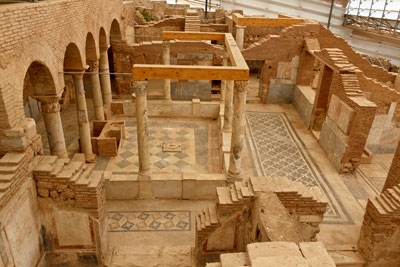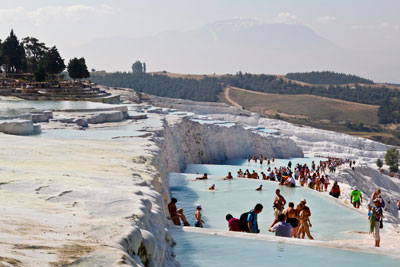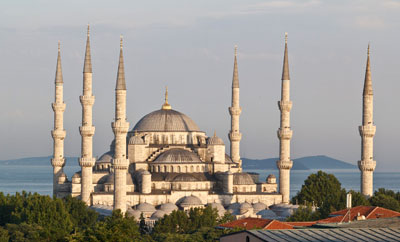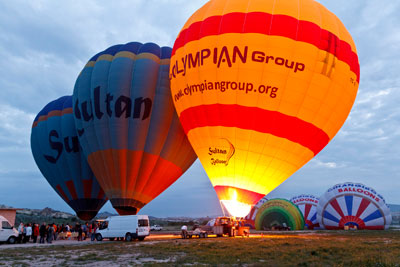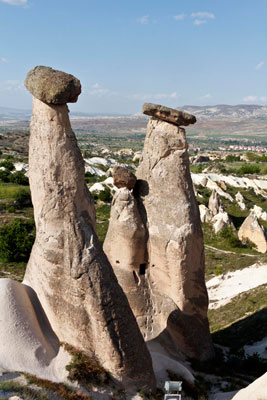Discovering Turkey on a self-drive tour
This article appears on page 6 of the March 2013 issue.
by Marcia Brandes, Atlanta, GA
My husband, Steve, and I like to travel independently. When we decided to plan a trip to Turkey, I checked out several group tours, but no itinerary included all the places I wanted to go. I also checked into a private guide recommended in International Travel News, but the cost was more than my budget allowed. I’m glad that, while browsing online, I discovered Efendi Travel (phone 510/418-4486 [November-March]) and its travel agent and guide Ozgur Guker.
Making arrangements
Ozgur lives part of the year in California and part of the year in Turkey. He was extremely helpful in offering suggestions for destinations I wouldn’t have considered including, in addition to arranging for a private guide in Cappadocia and encouraging us to drive ourselves around Turkey. Ozgur assured me that the roads were excellent and well signed and the drivers no crazier than in Italy or Greece, where we already had experience driving.
Our trip began May 17, 2012. We flew into Istanbul, staying there for four days. I had researched apartments on www.airbnb.com and decided to stay in the Taksim district. We rented a studio from Marti Apartments (phone +90 212 250 18 06) for $75 a night.
Our king-sized bed was very comfortable, and the small refrigerator was stocked with complimentary water.
The hostess, Sue Akyel, an American married to a Turkish man, was very easy to work with and quite helpful in showing us how to get tickets in advance for the major attractions in Istanbul.
We had no trouble using public transportation to get around Istanbul on our own. The tram was only a few blocks from the apartment and cost $1-$1.50 per trip. You can either buy individual tokens from a machine or load money onto a transit card.
We found excellent restaurants in the area, including many kebab places and Italian and Turkish cafés. The popular street I˙stiklâl, with its shops, nightclubs and restaurants, was only a short walk from the apartment.
Turkey is 99% Muslim, but the secular nature of the country makes this an interesting, not intimidating, factor for Westerners. I was continually fascinated by the variety of dress that we saw women wearing. On the streets of Istanbul, women dressed in black burkas — which left only their eyes uncovered — were walking and talking side by side with bare-headed women in jeans and sweaters.
Wining and dining
The secular nature of the country was also evident in the wide availability of alcoholic beverages, especially Turkish beer and wine. In fact, I found the wines to be very palatable, although Steve was not successful in locating dark beer. Vineyards dotted the hillsides and valleys throughout the areas we visited.
We found the food to be more Mediterranean than Middle Eastern, at least in the parts of the country we visited.
I think it would be hard to be a vegan visitor to Turkey. Breakfast usually consisted of bread, cheese, cold cuts, hard-boiled eggs, yogurt, honey, tomatoes and cucumbers. Fancier places added dried or fresh fruit and nuts and sometimes the Turkish version of Nutella. (Yum!)
Lunch tended to be sandwiches of meat and cheese or pastry with cheese, with tomatoes and cucumbers served on the side.
When Steve drank coffee, it was brewed the American way. We never did try the tea, but the apricot juice was outstanding.
Dinner was fun, as I never knew what the names on the menu really meant. Kebabs were pretty easy, though. A standard kebab plate had some variety of meat — beef, lamb or chicken — with rice, fried potatoes and the ubiquitous tomatoes and cucumbers.
The best food we encountered was in restaurants that were part of the boutique hotels or pensions where we stayed; in particular, the fresh fish was delicious. The food was not particularly spicy.
The interesting part came when I tried to decipher what the Turkish versions of “pizza,” “ravioli,” “fajitas” and “Chinese egg rolls” might be. Turkish pizza turned out to be flatbread with spices but little else. Ravioli was a glob of undercooked dough with (maybe) a speck of meat in the center. Neither of these was very tasty, in my opinion.
On the other hand, the fajitas, although not in any way resembling any fajita I have ever seen, turned out to be a very tasty chicken stew with potatoes, tomatoes, onions and peppers. The Chinese egg roll, which, according to the menu, had cheddar cheese, carrots and zucchini, had none of those but was, nevertheless, a delicious meat concoction in a crisp, fried pastry roll.
Guidebooks I read before our trip warned us not to drink the tap water or eat raw vegetables and fruit. We heeded part of this warning by buying and drinking only bottled water, which was inexpensive and readily available everywhere. But it was almost impossible not to eat salad, which was served with every meal, at least in the form of tomatoes and cucumbers and, frequently, lettuce.
Fruit was plentiful at some of the breakfast buffets, and street vendors proffered roasted corn on the cob and fresh watermelon.
Armed with a prescription for Cipro, which we had procured from a travel clinic before we left, after a few days we bravely began to consume these doubtful delicacies. When no dire consequences followed, we continued to munch our way across Turkey, enjoying the fresh produce.
From Istanbul to Cappadocia
Four days in Istanbul gave us plenty of time to visit all the major sights and take a 5-hour Bosporus cruise. From Istanbul we flew to Kayseri, in central Turkey.
Our flight on Turkish Airlines was reminiscent of the good old days of American flying. They served a light lunch with a sandwich, salad and dessert, even for a journey of just 1½ hours.
Prices on their website vary, depending on what time of day you fly, but our flights from Istanbul to Kayseri and, later, from Bodrum back to Istanbul totaled only $123 per person.
I had booked a rental car through www.economycarrentals.com. Once we exited the terminal, we saw a young man holding up a sign with our names; he had the car right there. No need to take a shuttle to the car lot!
I inspected the car, noting a small ding on one fender, before Steve took the wheel. The total cost for our diesel compact for 13 days, including full insurance, was $825. Petrol was expensive in Turkey, but the diesel got better mileage than a regular vehicle. We spent a total of $222 for fuel.
Once we were out of the city of Kayseri, the traffic was sparse and the roads were well paved. At first, the landscape was unremarkable. As we drew nearer Cappadocia, we began to notice some of the strange rock formations that make the area world famous.
Eons ago, the ash from three separate volcanoes settled in the valley between them. Over the years, the ash compacted to form rock. Continued eruptions deposited layers of lava on top, which became basalt.
As the basalt was harder than the compacted ash, erosion occurred unequally, sculpting fantastic spires and needles. The Turkish people say that man could not have built them and God was too busy, so they must have been created by fairies.
Caves formed in the relatively soft rock, and early Christians found them to be good places to hide from those who persecuted them. They expanded the caves into underground labyrinths of rooms, some six or seven stories deep. The rooms were usually used for storage or to house animals, but when the enemy approached, the Christians took refuge there.
Göreme valley
We had no trouble locating the town of Ürgüp, where we would be staying; the road signs were easy to follow. Once in the town, however, it was a different matter.
I had printed out what Google Maps said was the location of our hotel, but it proved to be incorrect. (In fact, throughout the trip, none of our hotels were exactly where Google Maps had put them.) Fortunately, I was able to find someone at a shop who was able to point us in the right direction.
Our hotel, the Ürgüp Inn Cave Hotel, was built into the side of a hill on a short, narrow street, and our room was, indeed, a cave. Omer, our host, told us that the room had once been a church, and the tall, vaulted ceiling made this a plausible story.
I had never stayed in a cave before. The room was pleasantly furnished and exotic. The lighting was rather dim, but the room did have a modern bathroom and even a small television. WiFi was available in the courtyard.
Our three nights there cost us $151.
The next day, Ozgur had arranged for a local guide to show us around at a cost of $125. Kadir, in his 20s, was a very personable, knowledgeable man with a university degree, and we enjoyed his company and his narration.
He met us promptly at 8:30 at the hotel and offered to drive our rental car so that we could devote all of our attention to the fantastic sights.
We spent the next eight hours ticking off the must-see places, one by one: the Göreme Open-Air Museum; Monks Valley; Love Valley; Pigeon Valley; the Zelve Open-Air Museum, and one of the underground cities.
We encountered a number of groups of schoolchildren, and there were the inevitable souvenir stands — even carpets for sale — at every location. Two of the places even had camels that one could sit on to have a photo taken. In spite of all the touristy trappings, these were truly amazing sites, unlike anything anywhere else in the world.
The next morning we arose at 4:15 to catch the van that would take us to the launch site for the hot-air balloon ride that I had booked through our hotel. The Cappadocia area is renowned for its hot-air ballooning, and on a good day as many as 100 balloons may be in the air at sunrise. Ballooning takes place only at dawn, before the wind currents become too strong.
We flew with Sultan Balloons (Ürgüp, Turkey). A one-hour flight cost €160 ($213) per person. The basket for the balloon held 24 people plus the pilot. We secured a good corner position, and I strapped my camera firmly around my neck.
The weather was cloudy — no blue sky for my photos — but I was thankful it wasn’t raining, as the flight would have been canceled. The view over the fairy chimneys was amazing!
That afternoon we drove to several of the other towns in the area, including Uçhisar and Göreme, lunching at an excellent café, Nazar Börek. The gözleme, a kind of toasted cheese sandwich, was delicious.
Then we drove to an area called Rose Valley, where we spent the afternoon hiking among the fairy chimneys. At one point, we weren’t sure which way to go, so Steve pulled out his iPad. Sure enough, the trails were on there, and we used this 21st-century device to guide us out of this ancient maze.
Konya
It was rainy the morning we left Cappadocia, but, since we were driving out of the area, that posed no problem for us. We took the highway to Konya, our midday stop.
Konya is one of the more conservative cities in western Turkey, as it is home to the mosque where the Whirling Dervishes originated. Once again, the maps I had printed from Google were no help; fortunately, there were brown “attraction” signs pointing the way to Mevlâna Müzesi.
The museum and mosque were mobbed with both tourists and worshipers. The museum houses relics of Mevlâna (Rumi), the 13th-century Muslim mystic who founded the Sufi order known as the Whirling Dervishes. Cases held items such as a lock of his hair, intricately decorated Korans and other memorabilia.
Thanks to the GPS in our trusty iPad, we found our way out of Konya and onto the road to Beyşehir, our stop for the night. The topography changed from Kansas to New England as we drove toward the lakeside town of Beyşehir.
Of all the accommodations on our trip, my least favorite was Beyşehir’s Atapark Hotel. The room was tiny, and it seemed “not ready for prime time,” as if the hotel had opened before being fully prepared for guests. The patio area was covered in sand and water, and there was construction going on on the road out front.
The advertised beach was a mere four feet wide, and there was only one other couple staying in the place. However, the food in the restaurant was good, as was the free breakfast, and it cost only $40 for the night.
On the road
Driving across western Turkey proved to be an adventure in itself. From Beyşehir to Antalya, the road climbed steadily over snow-covered mountains.
Though the speed limit was usually 90 kph, ours seemed to be the only vehicle actually going that speed. The right-hand lane of the 4-lane highway was frequently occupied by excruciatingly slow trucks grinding up the mountainside at no more than 20 kph. We also passed numerous buses that seemed to average about 60.
On the other hand, as we traveled in the left lane to pass these behemoths, cars would zoom up behind us, their drivers flashing their lights impatiently, encouraging us to change lanes so they could roar past at 120 kph or more. There was no in-between.
That was highway driving. City driving was a whole different animal.
If the highway seemed occupied by turtles and cheetahs, the cities were mazes of honking bumblebees.
The highways led right through the town centers, with stoplights at every block. The stoplights changed from red to yellow before turning green, and as soon as the yellow light appeared, horns started honking. Usually, cars did not wait for the light to turn green before proceeding across the intersection.
Three lanes in a town might contain four vehicles abreast, including a tractor, a large truck, a bus and a sedan. Furthermore, if one lane was slower because someone was turning onto a side street, cars would dart out in front of us with no signal, as if they were somehow encased in a force field that would protect them from collision. Most automobile drivers seemed to be aggressive young men, gesturing and honking as they drove.
And I haven’t mentioned the pedestrians! They were fearless, emerging from between parked cars without warning. Steve’s attention was devoted to driving the car, while I did all the navigating. I think it would have been very difficult to navigate as a solo driver.
Antalya
Our team effort worked well until we arrived in Antalya’s Old Town. The Kaleiçi district is a warren of tiny, one-way cobblestone streets lined with shops and filled with pedestrians. We actually managed to negotiate our way to the district, only to be stopped by a crossing gate barrier. Since we were staying at a hotel in Old Town and were supposed to be parking at the hotel, this was rather discouraging.
We eventually found a parking lot outside Kaleiçi, paid the fee and walked to our hotel, leaving our luggage in the trunk. The hotel manager walked back with us to the car and showed us how to enter through the gate.
It turns out you just get a ticket at the gate and drive on in. Our ticket showed a price of 100 lira ($57) per day, but guests staying at the hotels in town don’t have to pay.
We stayed at a lovely boutique hotel, the Hadrianus (phone +90 242 244 0030), which cost $226 for three nights, including a delicious daily breakfast buffet. There was also free WiFi, as was usual at every place we stayed.
The next morning we walked over to the Kaleiçi Museum, which houses a collection of tile work and dioramas of Anatolian life in the 19th century, then we took a tram to the Antalya Archeological Museum, with archaeological finds from the area dating from Paleolithic times to the 19th century. It is an outstanding museum, with explanations in both Turkish and English; audio guides were also available. Steve was particularly entranced by a small pottery “sippy cup” thousands of years old.
One of its major exhibits is a statue of Hercules that was reunited in 2011 with its missing half. The museum had the bottom half, while the Boston Museum of Fine Arts had the top. The BMFA finally acceded to Turkish demands to return it.
After viewing artifacts in the museums, we decided to venture out to some of the actual ancient sites, themselves. We drove first to Termessos National Park, in the boulder-strewn Taurus Mountains 34 kilometers north of Antalya. The ancient city was inhabited by Pisidians, a race so tough, they even fought off Alexander the Great.
The hike up to the ruins from the parking lot was quite strenuous, but it was interesting to climb around the old theater and see the structure of the walls that were still standing.
Not far from Termessos was another fascinating site, Karain Cave. This, too, entailed a hike up a steep hill.
The cave, itself, is one of the oldest settlements in Turkey, continually inhabited for 25,000 years. The site is under continued excavation, and much of what was uncovered is in the Antalya museum.
The cave goes back some distance into the mountain, with electric lighting illuminating some of the rooms. It was an eerie feeling to imagine what life must have been like for the inhabitants.
Pamukkale
From Antalya we drove north to Pamukkale, our next overnight stop. On the way we visited Aphrodisias, a stunning second-century site with well-preserved ruins of a stadium, the gateway to the city and a temple. It is necessary to park your car for five lira, then take the free shuttle to the actual site. Aphrodisias is out of the way but well worth the time it takes to get there.
Pamukkale, another UNESCO World Heritage Site, boasts the famous travertine terraces, formed from the mineral-rich hot springs that cascade down the hill. The aqua water against the snow-white travertine was a beautiful sight.
The entrance cost is 20 lira, and it is required that everyone remove their shoes. Even the guards are barefoot. Once past the entrance, visitors can walk up and down the terraces through the flowing water.
In Pamukkale we stayed at the Venus Hotel, just a short walk from the terraces. I had reserved a room through www.booking.com for €35. The hotel was a great place to stay, and the dinner we had there was the best of our whole trip.
After Pamukkale, we headed east to Selçuk to visit the nearby ruins at Ephesus. In Selçuk we stayed at Hotel Bella, a lovely, ivy-covered lodging with small but beautifully decorated rooms. The hotel offered a free ride to and from the ruins, which was a big plus as taxis are notoriously expensive there.
Our hotel stay cost €55 ($73) a night, and we enjoyed their prix fixe dinner for 25 lira ($14) each. The food was very good, but the best part was the view — straight into a stork’s nest, right at eye level. The storks spend their winters in Africa, then return to Selçuk each spring.
Ephesus is one of the premier tourist sites in Turkey. Had we wanted to spend an entire day there, we could have booked a guide through Ozgur. However, we had only half a day, so we used a guidebook that the hotel lent us.
The outdoor ruins were the most impressive we saw, especially the Library, but what really made Ephesus special were the terrace houses. Several stories of ancient dwellings are undergoing extensive archaeological study and renovation. The houses are under a protective canopy, and entry cost extra (15 lira), but we felt they were more than worth it. Intricate floor mosaics and wall paintings are taking shape as archaeologists piece together the pieces of this giant jigsaw puzzle.
Lake Bafa
One of the benefits of having our own transportation was that we could visit the countryside as well as the towns. The next day we drove along the Dilek Peninsula, visiting the national park and letting Steve dip his toes in the picture-perfect Aegean.
Our penultimate destination was Lake Bafa, a large inland area of water that used to be part of the Aegean. We were staying in the village of Kapikiri for three nights at the small Karia Pension (phone +00 90 252 543 54 90), where our rate of €70 per night included both breakfast and dinner.
The pension is run by Emin and his wife, who does the cooking and cleaning. The grounds were lovely, with dozens of flowers in bloom and outdoor cushions for enjoying the breeze from the lake. As with all of our other accommodations, I had booked reservations online before our trip began.
From Lake Bafa we drove to Bodrum, a trip of about 1½ hours. I wanted to see the harbor and visit the Castle of St. Peter, which has been turned into a museum. What a contrast to relaxing Lake Bafa! There were legions of tourists, hundreds of yachts and row after row of restaurants and shops selling everything from bikinis to used books.
The castle houses the Museum of Underwater Archaeology. Exhibits showcase treasures found on shipwrecks dating back as far as 1400 BC. One area has glass bottles and beads; another displays finds from a Greek vessel from about 480 BC.
We decided to forgo visiting the dungeons of the castle, but did enjoy the spectacular views of the harbor from its battlements.
Car confusion
At the Bodrum-Milas Airport, we turned in our rental car and flew back to Istanbul. I hope we turned it in to the right person!
We had told the rental company that we would be at the airport at 8 a.m., and when I had asked where we should go, their representative assured us, “They will find you” — a little vague, but that’s the only answer I could get.
We got to the airport a little early and circled around, not seeing anyone with a sign. When 8:00 arrived and there was still no sign of anyone, we parked by the drop-off curb and I got out to look around. A man approached and asked who I was looking for, and I showed him my paperwork. He called the number on the receipt, and they told him they didn’t know anything about it!
I was starting to get worried, as we had a plane to catch. The man asked if I had a business card from the car rental company, and I searched through my luggage until I found the card I had been given. He then called the number on the card, and after listening awhile he turned to me and said, “Okay, you can give the car to me.”
He then told me he had been looking for a rental car with a license number from Ürgüp, not Kayseri. (The first two digits of the license plates indicate where the car is from.)
I was skeptical — he had no name tag or anything showing who he was — but he did stay on the phone while he inspected the car and wrote down the mileage. He also found our iPad in the car and made sure Steve didn’t forget it.
I asked him to sign my paperwork and write down his phone number. What else could I do? We had a plane to catch.
Ending in Istanbul
We flew back to Istanbul for our last night in Turkey. For our final dinner there, I wanted it to be something special. We wandered around the Sultanhamet area looking for a rooftop restaurant where we would have a view of the Blue Mosque at sunset. The first place we tried did not serve alcohol, and I really wanted a glass of wine. The second place served only dessert, no meals. The third place was the charm.
The food at the Cozy Bar & Pub (Divanyolu Caddesi 66) was reasonably good and not too expensive, but the view was wonderful. If you want a seat by the railing, you need to make reservations. We were lucky to get a table.
We enjoyed the food, the sights and, especially, the people-watching in Turkey.
We found the people to be friendly and helpful. It was hard getting used to some of the pushy salesmen, but I did finally learn to say ‘No.’ It was a memorable trip.



